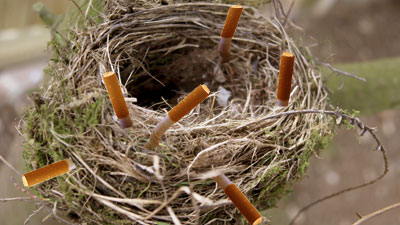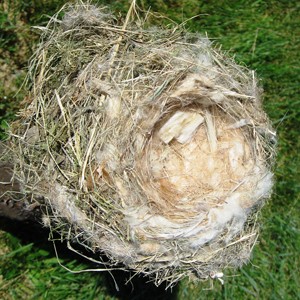It looks like you're using an Ad Blocker.
Please white-list or disable AboveTopSecret.com in your ad-blocking tool.
Thank you.
Some features of ATS will be disabled while you continue to use an ad-blocker.
3
share:

Well this sounded interesting, although I am not sure which forum it belongs in. Effective pest control and new technique utilized by a species sounds like ecology enough to warrant science/tech I suppose.
Birds are lining their nests with cigarette butts to repel pests and keep themselves warm, according to research
Makes sense, being that nicotine/tobacco has been a proven pest killer. There are plenty of butts around, so choosing to line a nest makes sense by availability alone.
Wild birds have long protected their nests from mite invasion by importing chemical-emitting plants.
I did not know this, crafty indeed. So it leads me to wonder if the birds figured this out after they chose the butts(because they make good, insulating nest material,made from cellulose/paper), or because they realized the number of pests, mites particularly, diminished with the new butt additions.
The scientists said it was possible the anti-mite nest protection was a happy coincidence. Birds might only be lining their nests with discarded butts because they provide good insulation.
Further studies could reveal if this is the case by offering the birds a choice of smoked and non-smoked butts. Either would do for insulation, but only filters from smoked cigarettes can effectively repel mites.
The team put traps in the nests of 27 house sparrows and 28 house finches on their university campus. The traps were outfitted with fibres and filters from smoked or unsmoked cigarettes and emanated heat to attract parasites.
"Birds could distinguish smoked and non-smoked butts from their scent, just as some birds that use the chemical compounds of plants as defence against parasites appear to rely on olfaction to collect those with effective chemicals," the scientists wrote.
Fascinating. It seems the birds chose the smoked butts over non-smoked, so maybe they do realize smoked butts deter mites, and this is why they use the butts for nesting. Nature never ease to amaze in it's practicality and effectiveness.
I wonder if one were to line their garden with smoked butts, would it have any effect? This would be a good recycling use for cigg butts, and cheaper than pesticides eh?
I am curious if this is occurring in other places besides New Mexico. Perhaps a bird collective realization? It would be cool to know when and where this has occurred.
"This novel behaviour observed in urban birds fulfils one of the three conditions necessary to be regarded as self-medication: it is detrimental to parasites."
On a side note, do those that enjoy substances, in a self medicating sense, do so partially because they feel some people, entities or life itself are parasitic? Kind of makes sense to me. I never thought of it like that, biology at work. Escapism may be warranted here, no? Who wants to feel parasites eating them or their young alive?
Anyone know what the other 2 necessary conditions are to be "regarded as self medicating?" Feeling deceived? Over or under stimulated? Chinese lanterns?
Peace,
spec
ETA: Source www.cbc.ca...
edit on 9-12-2012 by speculativeoptimist because: (no
reason given)
Not to be "that guy" but that photo looks fake.
Otherwise it's downright alarming that birds would make use of cigarette butts at all.
Otherwise it's downright alarming that birds would make use of cigarette butts at all.
reply to post by jough626
Yea that shot may be fake, it was on another source for the same article. Cig butts are nasty, but in this case they actually serve a good purpose.
ETA: Found an actual pic from Mexico City, and yea it is significantly different

Yea that shot may be fake, it was on another source for the same article. Cig butts are nasty, but in this case they actually serve a good purpose.
ETA: Found an actual pic from Mexico City, and yea it is significantly different

edit on 9-12-2012 by speculativeoptimist because: (no reason given)
reply to post by speculativeoptimist
"On a side note, do those that enjoy substances, in a self medicating sense, do so partially because they feel some people, entities or life itself are parasitic"
I accidentally closed the window that contained the link for the next two quotes. For this I apologize
www.ncbi.nlm.nih.gov...
I don't think so..
It would be my guess that birds partake in using cigarette butts because their brain tells them that the butts either contain or resemble the very chemical compounds of certain plants found in nature that they have used before. Or something along those lines...
A study should be done for sure!
"On a side note, do those that enjoy substances, in a self medicating sense, do so partially because they feel some people, entities or life itself are parasitic"
I accidentally closed the window that contained the link for the next two quotes. For this I apologize
History
During the early beginnings of life, nature developed the amygdalae as a defense response mechanism for animals. Recognizing danger patterns, the organs enabled animals to fight, freeze, or escape. As essential as the vertebrae, these organs protected fishes, amphibians, reptiles, birds and mammals from harm.
The amygdala triggers your emotions faster than your conscious awareness. The unique “speed dial circuits” of the two almond sized nuclei within your brain are the first to react to emotionally significant events. These organs protect you from harm by interpreting subconscious hints of danger to trigger lightning fast responses.
www.ncbi.nlm.nih.gov...
The present results suggest that the olfactory bulb projections in birds are generally similar to those in reptiles, with the exception that secondary olfactory bulb projections to the amygdala may be much reduced in birds compared to those in reptiles. The functional significance of the reduction in olfactory input to the amygdala is presently uncertain.
I don't think so..
It would be my guess that birds partake in using cigarette butts because their brain tells them that the butts either contain or resemble the very chemical compounds of certain plants found in nature that they have used before. Or something along those lines...
A study should be done for sure!
Mods please remove
edit on 9-12-2012 by MESSAGEFROMTHESTARS because: asdf
reply to post by MESSAGEFROMTHESTARS
That makes a little more sense than recognizing cause and effect with mites.
Thanks for the reply.
It would be my guess that birds partake in using cigarette butts because their brain tells them that the butts either contain or resemble the very chemical compounds of certain plants found in nature that they have used before.
That makes a little more sense than recognizing cause and effect with mites.
Thanks for the reply.
Hi folks,
On the same subject concerning cigarette butts... Apparently in the Paris metro there are quite a few large colonies of Afghanistan Crickets : see link : antoine.pagesperso-orange.fr...
Amongst various types of organic detritus that were found in the metro the crickets had quite a thing for discarded cigarette ends. Since the no smoking ban has come into effect within the metro apparently the colonies are supposedly diminishing...
Just thought i would share and sorry if i have not done the linky thing correctly, i'm stiil fairly new here.
Rodinus
On the same subject concerning cigarette butts... Apparently in the Paris metro there are quite a few large colonies of Afghanistan Crickets : see link : antoine.pagesperso-orange.fr...
Amongst various types of organic detritus that were found in the metro the crickets had quite a thing for discarded cigarette ends. Since the no smoking ban has come into effect within the metro apparently the colonies are supposedly diminishing...
Just thought i would share and sorry if i have not done the linky thing correctly, i'm stiil fairly new here.
Rodinus
reply to post by speculativeoptimist
Search is wonderful. This was recently posted in Fragile Earth:
Birds line nests with cigarette butts to repel pests
Search is wonderful. This was recently posted in Fragile Earth:
Birds line nests with cigarette butts to repel pests
edit on 10-12-2012 by Arbitrageur because: clarification
It would make sense that smoking is bad for more then just the addicted.
new topics
-
Bucks County commissioners vote to count illegal ballots in Pennsylvania recount
2024 Elections: 1 hours ago -
Trump sues media outlets -- 10 Billion Dollar lawsuit
US Political Madness: 1 hours ago -
Fired fema employee speaks.
US Political Madness: 2 hours ago -
How long till it starts
US Political Madness: 3 hours ago -
USSS Agent Fired for Having Sex In Michelle Obama's Bathroom
US Political Madness: 5 hours ago -
Watching TV
Jokes, Puns, & Pranks: 8 hours ago
top topics
-
RFK is Trumps health pick
2024 Elections: 16 hours ago, 20 flags -
How long till it starts
US Political Madness: 3 hours ago, 10 flags -
Trump sues media outlets -- 10 Billion Dollar lawsuit
US Political Madness: 1 hours ago, 10 flags -
Fired fema employee speaks.
US Political Madness: 2 hours ago, 9 flags -
USSS Agent Fired for Having Sex In Michelle Obama's Bathroom
US Political Madness: 5 hours ago, 8 flags -
Bucks County commissioners vote to count illegal ballots in Pennsylvania recount
2024 Elections: 1 hours ago, 8 flags -
Watching TV
Jokes, Puns, & Pranks: 8 hours ago, 6 flags
active topics
-
Trump sues media outlets -- 10 Billion Dollar lawsuit
US Political Madness • 3 • : Astrocometus -
WATCH LIVE: US Congress hearing on UFOs, unidentified anomalous phenomena
Aliens and UFOs • 71 • : putnam6 -
The Trump effect 6 days after 2024 election
2024 Elections • 122 • : Astrocometus -
Chancellor Rachel Reeves - Former Colleagues Say She Lied About Role as ‘Economist’
Politicians & People • 3 • : gortex -
Mike Tyson returns 11-15-24
World Sports • 39 • : Blueracer -
-@TH3WH17ERABB17- -Q- ---TIME TO SHOW THE WORLD--- -Part- --44--
Dissecting Disinformation • 3274 • : Thoughtful3 -
How long till it starts
US Political Madness • 5 • : Astrocometus -
The art of being offended
Social Issues and Civil Unrest • 48 • : TimBurr -
Fired fema employee speaks.
US Political Madness • 6 • : xuenchen -
RFK is Trumps health pick
2024 Elections • 10 • : nugget1
3
